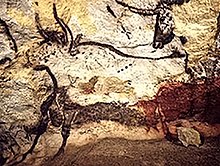History of art
Appearance

The history of art is the history of any activity or product made by humans in a visual form for aesthetical or communicative purposes, expressing ideas, emotions or, in general, a worldview.
Quotes
[edit]- The bizarre but all too common transformation of the woman artist from a producer in her own right into a subject for representation forms a leitmotif in the history of art. Confounding subject and object, it undermines the speaking position of the individual woman artist by generalizing her. Denied her individuality, she is displaced from being a producer and becomes instead a sign for male creativity.
- Whitney Chadwick Women, Art, and Society: Fourth Edition (2007) ISBN 0-500-20393-8
- The museums are here to teach the history of art and something more as well, for, if they stimulate in the weak a desire to imitate, they furnish the strong with the means of their emancipation.
- Edgar Degas, in: R. H. Ives Gammell, ed. The Shop-Talk of Edgar Degas University Press, Boston, 1961
- Mannerism came so late into the foreground of research on the history of art, that the depreciatory verdict implied in its very name is often still taken to be adequate, and the unprejudiced conception of this style as a purely historical category has be.
- Arnold Hauser. The Social History of Art, Volume I. From Prehistoric Times to the Middle Ages, 1999. Chapter 5. The Concept of Mannerism
- Asked to submit something for display by the Society of Independent Artists in New York [in 1917], Duchamp sent a urinal. Duchamp of course knew the history of art. He knew what had been achieved—how over the centuries art had been a powerful vehicle that called upon the highest development of the human creative vision and demanded exacting technical skill; and he knew that art had an awesome power to exalt the senses, the intellects, and the passions of those who experience it. Duchamp reflected on the history of art and decided to make a statement. The artist is a not great creator—Duchamp went shopping at a plumbing store. The artwork is not a special object—it was mass-produced in a factory. The experience of art is not exciting and ennobling—at best it is puzzling and mostly leaves one with a sense of distaste. But over and above that, Duchamp did not select just any ready-made object to display. In selecting the urinal, his message was clear: Art is something you piss on.
- Stephen Hicks (2004). Explaining Postmodernism: Skepticism and Socialism from Rousseau to Foucault Tempe AZ: Scholargy Press, p. 196
- The notion of style has long been the art historian's principal mode of classifying works of art. By style he selects and shapes the history of art.
- George Kubler summarizing the view of Meyer Schapiro (with whom he disagrees), quoted by Alpers in Lang, Berel (ed.), The Concept of Style, 1987, Ithaca: Cornell University Press, ISBN 0801494397
- In ceasing to subordinate creative power to any supreme value, modern art has brought home to us the presence of that creative power throughout the whole history of art.
- André Malraux Les voix du silence [Voices of Silence] (1951) Part IV, Chapter VI
- There's a machine which is called History of Art, which is a structure. And artist fits in this only because he or she is needed for this structure. If for example the History of Art needs some parallel lines, there is an individual who makes parallel lines. And this individual fits into this machine which works by itself; it doesn't care about people or anything else, it just goes by itself.
- Alexander Melamid, in: "The search for a people's art: painting by the numbers; interview with artist Alexander Melamid; includes related survey data and information," (1994), quoted in: Francis Halsall, Systems of Art: Art, History and Systems Theory, (2008) p. 67

